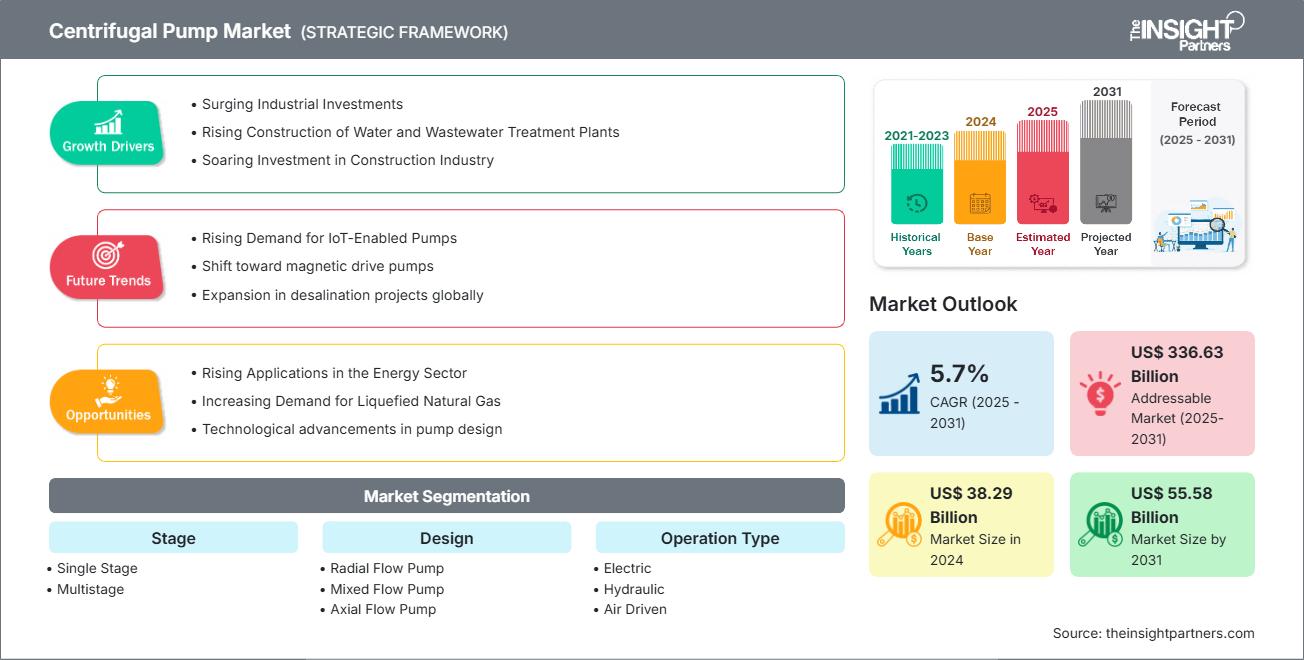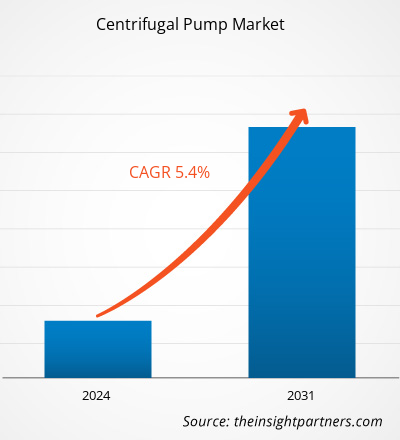من المتوقع أن يصل حجم سوق المضخات الطاردة المركزية إلى 55.58 مليار دولار أمريكي بحلول عام 2031 من 38.29 مليار دولار أمريكي في عام 2024. ومن المتوقع أن يسجل السوق معدل نمو سنوي مركب بنسبة 5.7٪ خلال الفترة 2025-2031.
تحليل سوق مضخات الطرد المركزي
تُحوّل مضخات الطرد المركزي الطاقة الحركية الدورانية إلى طاقة هيدروديناميكية لنقل السوائل. تُستخدم هذه المضخات في قطاعات مثل الزراعة، والمياه والصرف الصحي، والكيماويات، والنفط والغاز، والبناء. ويُعدّ تزايد تطوير البنية التحتية والطلب على حلول معالجة المياه من قوى النمو الرئيسية.
نظرة عامة على سوق مضخات الطرد المركزي
تُعدّ مضخات الطرد المركزي أساسيةً في البنية التحتية لمعالجة السوائل في مختلف الصناعات. فهي حلقة وصل حيوية تربط العمليات الصناعية بشبكات المياه البلدية. تشمل أنواع التصميم الرئيسية المضخات أحادية المرحلة ومتعددة المراحل، مع تمييزات إضافية حسب نوع الدافع (شعاعي، محوري، دافع مُعلّق، بين المحامل)، وفئات التدفق.
ستحصل على تخصيص لأي تقرير - مجانًا - بما في ذلك أجزاء من هذا التقرير، أو تحليل على مستوى الدولة، وحزمة بيانات Excel، بالإضافة إلى الاستفادة من العروض والخصومات الرائعة للشركات الناشئة والجامعات
سوق مضخات الطرد المركزي: رؤى استراتيجية

-
احصل على أهم اتجاهات السوق الرئيسية من هذا التقرير.ستتضمن هذه العينة المجانية تحليل البيانات، بدءًا من اتجاهات السوق وحتى التقديرات والتوقعات.
محركات وفرص سوق المضخات الطاردة المركزية
محركات السوق:
-
نمو البنية التحتية والتصنيع:
إن التوسع الحضري المتزايد والبناء والتوسع في التصنيع يدفع الطلب على قطاعات المياه والنفط والغاز والطاقة. -
احتياجات المياه والصرف الصحي:
إن الاستثمار في أنظمة الصرف الصحي والمياه النظيفة، وخاصة في إطار أهداف مثل الهدف السادس من أهداف التنمية المستدامة للأمم المتحدة، يغذي النمو. -
التركيز على كفاءة الطاقة:
مع تزايد عمليات الاحتيال والهجمات الإلكترونية عبر الإنترنت ، تطالب الشركات والعملاء بأنظمة دفع آمنة تحمي بياناتهم وتوقف الاحتيال. -
التوسع الزراعي:
إن الدعم المالي لمضخات المياه التي تعمل بالطاقة الشمسية والري يعمل على تعزيز نشر الطاقة الشمسية في المناطق الريفية في آسيا وأفريقيا. -
استثمارات البنية التحتية الخاصة بالصناعة:
ارتفاع الطلب في القطاعات الكيميائية والصيدلانية والنفط والغاز.
فرص السوق:
-
طرح أنظمة المضخات الذكية:
تعمل المضخات الذكية ذات المراقبة في الوقت الفعلي والصيانة التنبؤية والتوائم الرقمية على تعزيز الكفاءة التشغيلية وتقليل وقت التوقف عن العمل ودعم التشخيص عن بعد، مدفوعة بالصناعة 4.0 وتبني إنترنت الأشياء الصناعي واحتياجات الأتمتة المتزايدة. -
اعتماد المضخات الهندسية المستدامة والخضراء:
تُخفّض المضخات الصديقة للبيئة استهلاك الطاقة والانبعاثات، بما يتماشى مع الالتزامات البيئية العالمية وأهداف الاستدامة. تتبنى الصناعات تقنيات موفرة للطاقة لتلبية متطلبات اللوائح التنظيمية وتعزيز أداء الحوكمة البيئية والاجتماعية وحوكمة الشركات. -
الطلب على المضخات القابلة للتخصيص والوحدات المعيارية:
تُفضّل الصناعات الدوائية والكيميائية تصميمات المضخات المعيارية لقابليتها للتوسع، وتوافق المواد، ومرونة العمليات. يضمن التخصيص التكامل الفعال، والنشر السريع، والأداء المُصمّم خصيصًا للتطبيقات المعقدة أو الخاضعة للتنظيم. -
التوسع في المناطق الناشئة:
توفر الأسواق الناشئة في منطقة آسيا والمحيط الهادئ وأمريكا اللاتينية والشرق الأوسط وأفريقيا فرص النمو بسبب التوسع الحضري المتزايد والطلب على البنية التحتية الحديثة للمياه والصرف الصحي والبنية التحتية الصناعية في ظل أنظمة قديمة غير كافية.
تحليل تجزئة تقرير سوق مضخات الطرد المركزي
يُقسّم سوق مضخات الطرد المركزي إلى قطاعات مختلفة لتوضيح آلية عمله، وإمكانات نموه، وأحدث التوجهات. فيما يلي منهجية التقسيم القياسية المستخدمة في معظم تقارير الصناعة:
حسب المرحلة:
-
مرحلة واحدة:
تُهيمن المضخات أحادية المرحلة على سوق مضخات الطرد المركزي العالمية، حيث ستستحوذ على الحصة الأكبر منها بحلول عام ٢٠٢٤. وتُفضّل هذه المضخات لبساطة تصميمها، وانخفاض تكلفتها الأولية، وسهولة صيانتها. وهي مناسبة للتطبيقات التي تتطلب تدفقًا وضغطًا معتدلين، مثل الزراعة، وإمدادات المياه، والمهام الصناعية الخفيفة. -
متعدد المراحل:
رغم تعقيدها، تُعد المضخات متعددة المراحل أساسية في تطبيقات الضغط العالي، مثل تغذية الغلايات، وضخ الآبار العميقة، وعمليات النفط والغاز. ويتزايد استخدامها باستمرار، لا سيما في مشاريع توليد الطاقة والتعدين والبنية التحتية.
حسب التصميم:
-
مضخات التدفق الشعاعي:
هذه هي أكثر أنواع مضخات الطرد المركزي شيوعًا، حيث يُفرَّغ السائل عموديًا على العمود. تُستخدم على نطاق واسع في التطبيقات الصناعية والبلدية والتجارية، وخاصةً في ظروف الضغط العالي وانخفاض التدفق.
-
مضخات التدفق المختلط:
تجمع هذه المضخات بين خصائص التدفق الشعاعي والمحوري، مما يوفر ضغطًا وتدفقًا معتدلين. وهي مثالية لأنظمة الري والتحكم في الفيضانات وتبريد المياه.
-
مضخات التدفق المحوري:
صُممت هذه المضخات لنقل كميات كبيرة من المياه عند مناسيب منخفضة، وتُستخدم في تطبيقات الصرف الصحي والتوزيع والبحرية. مع تزايد التركيز على إدارة مياه الصرف الصحي والفيضانات، يتزايد الطلب على مضخات التدفق المحوري، وخاصةً في منطقة آسيا والمحيط الهادئ.
حسب نوع العملية:
- كهربائي
- هيدروليكي
- مدفوعة بالهواء
حسب النوع:
- المكره المعلق
- معلق عموديا
- بين المحمل
بواسطة المستخدم النهائي:
- صناعي
- سكني
- زراعة
- تجاري
حسب الجغرافيا:
- أمريكا الشمالية
- أوروبا
- آسيا والمحيط الهادئ
- أمريكا اللاتينية
- الشرق الأوسط وأفريقيا
رؤى إقليمية حول سوق مضخات الطرد المركزي
قام محللو شركة "ذا إنسايت بارتنرز" بشرح شامل للاتجاهات والعوامل الإقليمية المؤثرة في سوق مضخات الطرد المركزي خلال فترة التوقعات. ويناقش هذا القسم أيضًا قطاعات سوق مضخات الطرد المركزي ونطاقها الجغرافي في أمريكا الشمالية، وأوروبا، وآسيا والمحيط الهادئ، والشرق الأوسط وأفريقيا، وأمريكا الجنوبية والوسطى.
نطاق تقرير سوق مضخات الطرد المركزي
| سمة التقرير | تفاصيل |
|---|---|
| حجم السوق في عام 2024 | 38.29 مليار دولار أمريكي |
| حجم السوق بحلول عام 2031 | 55.58 مليار دولار أمريكي |
| معدل النمو السنوي المركب العالمي (2025 - 2031) | 5.7% |
| البيانات التاريخية | 2021-2023 |
| فترة التنبؤ | 2025-2031 |
| القطاعات المغطاة |
حسب المرحلة
|
| المناطق والبلدان المغطاة |
أمريكا الشمالية
|
| قادة السوق وملفات تعريف الشركات الرئيسية |
|
كثافة اللاعبين في سوق مضخات الطرد المركزي: فهم تأثيرها على ديناميكيات الأعمال
يشهد سوق مضخات الطرد المركزي نموًا سريعًا، مدفوعًا بتزايد طلب المستخدمين النهائيين نتيجةً لعوامل مثل تطور تفضيلات المستهلكين، والتقدم التكنولوجي، وزيادة الوعي بفوائد المنتج. ومع تزايد الطلب، تعمل الشركات على توسيع عروضها، والابتكار لتلبية احتياجات المستهلكين، والاستفادة من الاتجاهات الناشئة، مما يعزز نمو السوق.

- احصل على نظرة عامة على أهم اللاعبين الرئيسيين في سوق المضخات الطاردة المركزية
تحليل حصة سوق مضخات الطرد المركزي حسب المنطقة الجغرافية
تشهد منطقة آسيا والمحيط الهادئ نموًا ملحوظًا، مدفوعًا بالتصنيع السريع والتوسع الزراعي ومشاريع البنية التحتية. وتتمتع الأسواق الناشئة في أمريكا اللاتينية والشرق الأوسط وأفريقيا بفرص واعدة لتوسيع أعمال موردي مضخات الطرد المركزي.
يختلف نمو سوق مضخات الطرد المركزي من منطقة لأخرى نظرًا لنضج الأسواق وفرصها المستقرة في قطاعات النفط والغاز، ومرافق المياه، والتحديثات التنظيمية. فيما يلي ملخص لحصة السوق واتجاهاتها حسب المنطقة:
1. أمريكا الشمالية
-
الحصة السوقية:
تمتلك حصة كبيرة من سوق المضخات الطاردة المركزية العالمية -
العوامل الرئيسية:
- بنية تحتية قوية وقاعدة صناعية، بما في ذلك النفط والغاز والمواد الكيميائية ومعالجة المياه
- الطلب كبير من قطاع الطاقة، بما في ذلك الغاز الصخري وتوليد الطاقة
- تؤدي أنظمة المياه والصرف الصحي البلدية القديمة إلى زيادة احتياجات الاستبدال والتحديث
-
الاتجاهات:
ارتفاع الاستثمار في مشاريع الطاقة المتجددة والتحديث في قطاعات المرافق والقطاعات الصناعية
2. أوروبا
-
الحصة السوقية:
حصة كبيرة، خاصة في التطبيقات الصناعية والبيئية -
العوامل الرئيسية:
- تعمل اللوائح البيئية الصارمة للاتحاد الأوروبي (على سبيل المثال، توجيه التصميم البيئي) على تعزيز المضخات الموفرة للطاقة
- قطاعات التصنيع والكيميائية والصيدلانية الراسخة
- ارتفاع الطلب على إعادة تدوير المياه ومعالجة مياه الصرف الصحي
-
الاتجاهات:
تزايد اعتماد المضخات المدعومة بتقنية إنترنت الأشياء وحلول مراقبة الحالة
3. آسيا والمحيط الهادئ
-
الحصة السوقية:
المنطقة الأسرع نموًا مع حصة سوقية متزايدة كل عام -
العوامل الرئيسية:
- التوسع الحضري السريع والتصنيع والميكنة الزراعية
- الاستثمار الحكومي في مشاريع الري ومعالجة مياه الصرف الصحي والمدن الذكية
- زيادة قدرة توليد الطاقة وأنشطة استكشاف النفط والغاز في الصين والهند وجنوب شرق آسيا
-
الاتجاهات:
التركيز القوي على التصنيع المحلي وخطوط الإنتاج الفعالة من حيث التكلفة
4. أمريكا الجنوبية والوسطى
-
الحصة السوقية:
معتدل ومتوسع، مع زيادة الطلب في الزراعة والتعدين -
العوامل الرئيسية:
- احتياجات الري الزراعي المتزايدة في البرازيل والأرجنتين
- توسع قطاعي التعدين ومعالجة المعادن في تشيلي وبيرو
- الجهود المبذولة لتحسين البنية التحتية لإمدادات المياه والصرف الصحي
-
الاتجاهات:
المساعدات الإنمائية والاستثمار الأجنبي يعززان مشاريع البنية التحتية للمياه والمرافق
5. الشرق الأوسط وأفريقيا
-
الحصة السوقية:
على الرغم من صغر حجمها، إلا أنها تنمو بسرعة -
العوامل الرئيسية:
- استثمارات قوية في محطات تحلية المياه، والتبريد المركزي، ومنشآت النفط والغاز في دول مجلس التعاون الخليجي
- الحاجة الملحة إلى حلول موثوقة لضخ المياه في الزراعة والتنمية الريفية
- نمو توليد الطاقة والتعدين في منطقة أفريقيا جنوب الصحراء الكبرى
-
الاتجاهات:
ترقيات البنية التحتية بهدف تحسين توزيع المياه وأنظمة التحكم في الفيضانات
كثافة اللاعبين في سوق مضخات الطرد المركزي: فهم تأثيرها على ديناميكيات الأعمال
كثافة السوق العالية والمنافسة
وتشمل قائمة اللاعبين العالميين الرئيسيين كل من Xylem Inc.، وGrundfos، وFlowserve، وKSB SE & Co.، وSulzer، وEbara، وWeir Group، وWilo، وITT Corp.، إلى جانب قادة إقليميين مثل Kirloskar Brothers (الهند).
- المميزات الاستراتيجية المميزة التركيز على التصميم الموفر للطاقة، والمراقبة الذكية المدعومة بتقنية إنترنت الأشياء، والتكوينات المعيارية، والخدمات ذات القيمة المضافة مثل الصيانة التنبؤية.
الفرص والتحركات الاستراتيجية
- التوسعات العالمية (على سبيل المثال، افتتاح شركة Xylem لمنشأة جديدة في مصر)، وعمليات الدمج والاستحواذ، والابتكار في المنتجات عبر المضخات الذكية والمستدامة.
الشركات الرئيسية العاملة في سوق المضخات الطاردة المركزية هي:
- شركة إيبارا
- شركة جروندفوس القابضة
- شركة كيرلوسكار براذرز المحدودة
- شركة سولزر المحدودة
- مجموعة وير بي إل سي
- شركة زيلم
- مضخات جورمان-روب
- فايفز ساس
- شركة أطلس كوبكو
- شركة باركر هانيفين
إخلاء المسؤولية: الشركات المذكورة أعلاه ليست مرتبة بأي ترتيب معين.
الشركات الأخرى التي تم تحليلها أثناء البحث:
- شركة كيه إس بي إس إي آند كو كيه جي إيه
- صناعات بليجر
- شركة تسورومي للتصنيع المحدودة
- ويلو إس إي
- مجموعة SHI Cryogenics
أخبار سوق المضخات الطاردة المركزية والتطورات الأخيرة
-
سولزر ومانوير توقعان شراكة خدمة استراتيجية لمدة عشر سنوات في قطر
دخلت شركة سولزر في شراكة مع مانوير ذ.م.م، وهي شركة رائدة في تقديم الخدمات الهندسية، والذراع النفطية والغازية لشركة المناعي، بهدف تعزيز توافر وجودة خدمات إصلاح المعدات الدوارة في جميع أنحاء قطر. -
افتتحت شركة سولزر منشأة جديدة للمضخات عالية الأداء في موقعها بالمكسيك
احتفلت شركة سولزر مؤخرًا بالافتتاح الرسمي لمركز اختبار وتجميع جديد في مدينة مكسيكو، والذي تم بناؤه إلى جانب منشأة تصنيع المضخات الحالية. -
Xylem تكمل عملية الاستحواذ على Evoqua
أعلنت شركة Xylem Inc.، الشركة العالمية الرائدة في مجال تكنولوجيا المياه ("Xylem" أو "الشركة")، أنها أكملت استحواذها على شركة Evoqua Water Technologies Corp. ("Evoqua")، الشركة الرائدة في حلول وخدمات معالجة المياه ذات الأهمية الحرجة، في صفقة أسهم بالكامل تقدر قيمتها بحوالي 7.5 مليار دولار أمريكي.
تغطية تقرير سوق مضخات الطرد المركزي والنتائج المتوقعة
يقدم تقرير "حجم سوق المضخات الطاردة المركزية والتوقعات (2021-2031)" تحليلاً مفصلاً للسوق يغطي المجالات التالية:
- حجم سوق المضخات الطاردة المركزية وتوقعاتها على المستويات العالمية والإقليمية والوطنية لجميع قطاعات السوق الرئيسية التي يغطيها النطاق
- اتجاهات سوق المضخات الطاردة المركزية، بالإضافة إلى ديناميكيات السوق مثل المحركات والقيود والفرص الرئيسية
- تحليل مفصل لـ PEST و SWOT
- تحليل سوق المضخات الطاردة المركزية الذي يغطي اتجاهات السوق الرئيسية والإطار العالمي والإقليمي والجهات الفاعلة الرئيسية واللوائح والتطورات الأخيرة في السوق
- تحليل المشهد الصناعي والمنافسة الذي يغطي تركيز السوق، وتحليل خريطة الحرارة، واللاعبين البارزين، والتطورات الأخيرة لسوق المضخات الطاردة المركزية
- ملفات تعريف الشركة التفصيلية
- التحليل التاريخي (سنتان)، سنة الأساس، التوقعات (7 سنوات) مع معدل النمو السنوي المركب
- تحليل PEST و SWOT
- حجم السوق والقيمة / الحجم - عالمي، إقليمي، بلد
- الصناعة والمنافسة
- مجموعة بيانات إكسل
التقارير الحديثة
تقارير ذات صلة
شهادات العملاء
سبب الشراء
- اتخاذ قرارات مدروسة
- فهم ديناميكيات السوق
- تحليل المنافسة
- رؤى العملاء
- توقعات السوق
- تخفيف المخاطر
- التخطيط الاستراتيجي
- مبررات الاستثمار
- تحديد الأسواق الناشئة
- تحسين استراتيجيات التسويق
- تعزيز الكفاءة التشغيلية
- مواكبة التوجهات التنظيمية






















 احصل على عينة مجانية ل - سوق المضخات الطاردة المركزية
احصل على عينة مجانية ل - سوق المضخات الطاردة المركزية